Students can Download 1st PUC Biology Previous Year Question Paper March 2019 (South), Karnataka 1st PUC Biology Model Question Papers with Answers helps you to revise the complete Karnataka State Board Syllabus and score more marks in your examinations.
Karnataka 1st PUC Biology Previous Year Question Paper March 2019 (South)
Time: 3.15 Hours
Max Marks: 70
General Instructions:
- The question paper consists of four parts A, B, C, and D.
- All the parts are compulsory.
- Draw diagrams wherever necessary. Unlabelled diagrams or illustrations do not attract any marks.
Part – A
Answer the following questions in one word / one sentence each: ( 10 × 1 = 10 )
Question 1.
Define species.
Answer:
Species is the lowest level of organization and organisms belonging to a particular species have similar morphological, anatomical & physiological characters and can interbreed to produce fertile offsprings.
Question 2.
What is the hypogynous flower?
Answer:
- In a hypogynous flower, the thalamus is convex of flat and gynoecium occupies topmost position and other floral parts originate below.
- In epigynous flowers, the thalamus is cup-shaped enclosing the ovary and the floral parts will be arranged above it.
- In hypogynous flowers, the ovary is superior in epigynous flowers, the ovary is inferior.
Question 3.
Who proposed the ‘fluid mosaic model’ of the plasma membrane?
Answer:
S.J. Singer and G Nicolson.
Question 4.
What is mycorrhiza?
Answer:
All fungi are heterotrophs -they are saprotrophs or parasites or live as symbionts in the roots of higher plants (mycorrhizae) and in lichens (mycobiont).
Question 5.
Mention any two nitrifying bacteria.
Answer:
Double-stranded DNA.
![]()
Question 6.
What is Asthma?
Answer:
It is the parietal blocking of bronchi and bronchioles, resulting in breathlessness, chest tightness, wheezing and dry cough.
Question 7.
Which part of the brain contains corpora Quadrigemina?
Answer:
Midbrain.
Question 8.
How trichomes are helpful to plants.
Answer:
In a dicot stem, some of the cells of the epidermis give out multicellular epidermal hairs called stem hairs or trichomes.
Question 9.
At the end of meiosis how many haploid cells are formed?
Answer:
Four cells
Question 10.
What is resting potential?
Answer:
At the resting stage i.e., when the neuron is not involved in the conduction of impulses, the membrane of the neuron is more permeable to K+ ions than to Na+ ions. The membrane is impermeable to the negatively charged proteins of the axoplasm and also Cl” ions.
PART-B
Answer any FIVE of the following questions in 3-5 sentences each, wherever applicable. (5 × 2 = 10)
Question 11.
What are lichens? Mention its components.
Answer:
Lichens are composite organisms, composed of algae and certain fungi that live in a symbiotic biotic association.
The algal partner is called phycobiont and the fungal partner is called mycobiont.
![]()
Question 12.
List any four physiological effects of Auxins.
Answer:
Auxins can stimulate cell division, cell elongation, and cell maturation.
- It promotes Apical dominance.
- It initiates Root formation.
- Can promote parthenocarpy.
- Prevent premature fall of flowers, buds, and leaves.
- 2, 4D, and 2, 4, 5T are used as selective weedicides.
- Promote phototrophic and hydrotropic movements.
- Promote xylem differentiation.
Question 13.
Write the role of pepsin and rennin in the stomach.
Answer:
1. Pepsin: It is an enzyme produced in an inactive form called pepsinogen. Pepsinogen is activated by HCI. Pepsin is an endopeptidase and it breaks inner peptide bonds of the protein molecule to form proteoses, peptones, and polypeptides.
![]()
2. Renin: Renin is also secreted in an inactive form called prorenin. It is activated by HCI. Renin acts on the milk protein called casein and convert it into paracasein. Paracasein in turn combines with calcium salts and forms calcium Paracaseinate (curdy precipitate).

This process of conversion into calcium Paracaseinate is called the curdling of milk.
Question 14.
Mention the proteins found in thick and thin filaments of myofibrils.
Answer:
Acting myosin.
Question 15.
Differentiate between exocrine and endocrine glands.
Answer:
Exocrine gland:
Duct bearing glands, which release their secretions to the target organs directly through the ducts are called exocrine glands e.g: Salivary glands.
Endocrine glands:
Ductless glands which release their secretions to the blood circulation are called endocrine glands. e.g: Pituitary gland.
Question 16.
Write any four salient features of phylum Ctenophora.
Answer:
They are commonly known as sea walnuts or comb jellies.
- They are exclusively marine.
- They are of tissue level of body organization.
- They have the diploblastic conditions and are radially symmetrical.
- The body bears eight external rows of ciliated comb plates which helping in the locomotion.
- Digestion is both extracellular and intracellular.
- Reproduction takes place only by sexual means.
- Fertilization is external and development is indirect.
- Special property in ctenophores is Bioluminescence.
Question 17.
Mention the factors which help in the binding of O2 with hemoglobin.
Answer:
PO2PCO2, Temp, H+ ion cone
![]()
Question 18.
Classify chromosomes based on the position of the centromere.
Answer:
Classification of chromosomes based on the position of centromere:
(a) Metacentric type: Here the centromere is exactly at the center of two chromatids. It looks V-shaped during anaphase.
(b) Sub metacentric type: Here the centromere is eccentric in position so that one of the chromatids is long and the other is shorter. It looks L – shaped during anaphase.
(c) Acrocentric type: Here the centromere is almost towards one end of the chromatid to form a very long arm and another very short arm. It looks hook-shaped during anaphase.
(d) Telocentric type: Here the centromere is towards one end of the chromatid such that one chromatid is only present. It looks rod-shaped during anaphase.
PART-C
Answer any FIVE of the following questions in 40 to 80 words each, wherever applicable. (5 × 3 = 15)
Question 19.
Assign the following plants to their respective families.
(a) Groundnut
(b) Tomato
(c) Onion
Answer:
(a) Papillionaceae
(b) Solanaceae
(c) Liliaceae.
Question 20.
Write the events of the Telophase of mitosis.
Answer:
Telophase (Gr:telos-end; phases-stage):
It is characterized by the following features.
- Here, reversal of the prophasic events occur. The daughter chromosomes move and reach the opposite poles where they become thin and thread-like again. These threads overlap one another to form a fine chromatin network.
- The spindle fibers disintegrate and disappear.
- Reconstitution of a new nuclear envelope occurs. Nucleolus reappear.
Question 21.
Write any three uses of ethylene.
Answer:
- Only gaseous plant hormone.
- Product of metabolism of amino acid methionine.
- Ethylene is a fruit ripening agent.
- Promotes senescence of flowers, leaves, and fruits.
- Initiates flowering in pineapple.
Question 22.
Briefly explain the process of coagulation of blood.
Answer:
The mechanism of blood clotting is explained by various theories out of these ‘Best and Taylor’s theory is one.
Chemical events leading to the formation of blood clots as suggested by ‘Best and Taylor’s theory can be represented as follows.

The reaction shown above indicates that the inactive Prothrombin is converted into active thrombin by the catalytic activity of enzyme Thromboplastin in the presence of Ca2+. The activated thrombin reacts with soluble fibrinogen, resulting in the formation of insoluble fibrin. The fibrin threads form a mesh-like network in which the blood components get entangled, and results in blood clots and thus prevents bleeding.
![]()
Question 23.
Mention and explain any three taxonomical aids.
Answer:
The collection of specimens that help in the identification of a species are called taxonomic aids. Some of the major taxonomic aids are:
- Herbarium: A herbarium is defined as a collection of plants that have been dried, pressed, and preserved on sheets. These sheets are arranged in accordance with any accepted system of classification and they form a repository for future use. The date and place at collection are marked on sheets.
- Botanical Gardens: These specialized gardens have collections of living plants for reference. Plant species in these gardens are grown for identification purposes and each plant is labeled indicating its scientific name and its family.
- Museum: Museums are those places that have collections of preserved animals and plants for taxonomic studies.
- Zoological parks: These are places that have wild animals kept in protected environments under human care and which enable us to learn about their food habits and behavior.
- Keys: A key is an analytical scheme for the identification of plants and animals based on similarities and differences.
Question 24.
Dicot root does not possess cambium, yet it shows secondary growth. Comment on.
Answer:
In the dicot root, the vascular cambium is completely secondary in origin. It originates from the tissue located just below the phloem bundles, a portion of pericycle tissue, above the protoxylem forming a complete and continuous wavy ring, which later becomes circular, further events are similar to dicotyledon stem.
Question 25.
Bile juice, enterokinase, and HCl are essential for digestion. Give reasons.
Answer:
Bile salts emulsify the fats by lowering their surface tension and convert them into numerous tiny droplets. Bile is rich in sodium bicarbonate; hence it neutralizes the acidic chyme. It also helps in the absorption of fat-soluble vitamin K.
![]()
Enterokinase: It is a nondigestive intestinal enzyme and acts as an activator. It activates the inactive form trypsinogen of pancreatic juice into trypsin.
![]()
HCl present in the gastric juice gives acidic PH for the action of enzymes and also kills harmful bacteria.
HCl activates and converts pepsinogen into pepsin, and prorenin into rennin.
Question 26.
Why transmission of impulse across an electrical synapse is always faster?
Answer:
Electrical Synapses:
- The membranes of the pre-synaptic and post-synaptic neurons are in close proximity and there is no synaptic cleft.
- Electrical current can flow directly from one neuron to the other.
- Impulse conduction is faster.
- Electrical synapses are rare in the human system.
Part-D (Section -I)
I. Answer any FOUR of the following questions in 200-250 words each. (4 × 5 = 20)
Question 27.
Give an account of sporophytic generation in Pteridophytes.
Answer:
1. Their life cycle, comprises a distinct diploid phase represented by a sporophyte and a haploid phase by a gametophyte exhibiting heteromorphic alternation of generations.
2. Sporophyte represents the dominant phase of the life cycle, which is an entirely independent plant body. It bears roots, stems, and leaves. It reproduces asexually by sporangia.
3. The sporangia may be arranged in specific groups called sorus. In a few cases, sporangial structures aggregate on a specialized reproductive structure called strobilus or cone.
4. In sporophyte the vegetative structure shows highly specialized conducting tissues namely xylem and phloem. These tissues are organized into the vascular system called stele.
5. The gametophyte through independence is short-lived. It bears both male and female reproductive structures namely, antheridia and archegonia respectively.
6. Gametophytes thus show Oogamous types of sexual reproduction like Bryophytes. Water is essential for fertilization. The zygote develops into a multicellular embryo.
![]()
Question 28.
Explain the structure of the chloroplast with a diagram.
Answer:
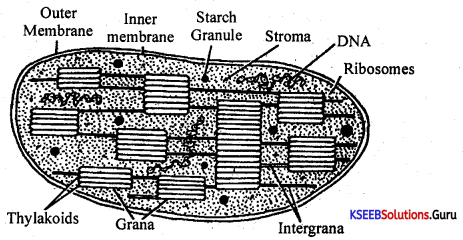
Electron microscopic structure of the chloroplast Chlorophyll containing plastids is called Chloroplasts. They are present in the cells of all green plants and abundant in the leaf mesophyll cells. They are elliptical or oval in shape. Chloroplast is bounded by two membranes with the intermembrane space called peri plastidial space, containing peri plastidial fluid. It is made up of H20, mineral ions, proteins, etc. It is a lubricating fluid that avoids friction between the two membranes.
The inner chamber is filled with a colorless proteinaceous fluid matrix called the stroma. Besides abundant proteins, stroma contains 70s ribosomes, circular DNA, and all the enzymes of the Calvin cycle. Embedded in the stroma, there are green-colored bodies called grana, which are interconnected by frets.
Grana is the site of light reaction, each granum consists of a stack of lipoprotein membrane discs called Thylakoids. Each thylakoid contains several photosynthetic centers called Quantasomes. Each quantasome contains about 250 chlorophyll pigments and a few xanthophylls and carotenes.
Only chlorophyll- a is capable of harvesting light energy into photosynthesis and hence it is called the primary photosynthetic pigment. All the other pigments, merely absorb light energy and pass it on to chlorophyll, and hence are called accessory photosynthetic pigments.
Question 29.
Describe the functions of any five essential nutrient elements in the plant cells.
Answer:
(A) Nitrogen :
It is absorbed as NO3-, NO2- and NH4+ ions.
Functions:
It is a major constituent of amino acids, proteins, nucleic acids, vitamins, etc.
(B) Sulphur:
It is obtained as sulfates (50/- ions).
Functions:
- It is the constituent of amino acids, methionine, and cystine.
- It also forms part- of ferredoxin, and vitamins like thiamine, biotin, and coenzyme-A.
(C) Phosphorus:
It is absorbed by plants in the form of phosphate ions, either as H2PO4– or HPO43-
Functions:
- It is a constituent of nucleotides and nucleic acids.
- It is present in cell membranes as phospholipids.
- It is involved in phosphorylation reactions and energy metabolism ATP.
(D) Potassium: Potassium is taken in as potassium ions (K+). It is more abundant in meristematic tissues like buds, root-tips, and youn£ leaves.
Functions:
- It determines the anion-cation balance in cells.
- It controls the opening and closing of stomata.
- It maintains turgidity (osmotic balance) in cells.
- It activates a number of enzymes.
- It is also involved in protein synthesis.
(E) Magnesium: It is absorbed as Mg+ ions by the plants.
Functions:
- It is a constituent of chlorophyll (forms the central atom of the porphyrin ring).
- It maintains the ribosome structure for protein synthesis.
- It activates the enzymes of phosphate metabolism in respiration and photosynthesis.
- It is also involved in the synthesis of DNA, RNA, and the activation of enzymes.
![]()
Question 30.
Sketch and label the L.S. of the human kidney.
Answer:
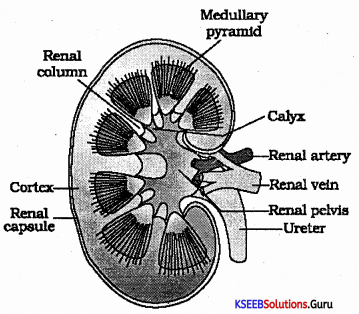
Question 31.
What are proteins? Describe the four levels of protein structure. (3M)
Answer:
Definition: Proteins are the building block is of the living body, and make up the structure and functional component of the living system. They are polymers made up of monomers called amino acids, linked by peptide bonds.
Protein structure:
The protein structure is referred to as a three-dimensional structure or conformation, which determines the biological function. Four basic structural levels are assigned to proteins.
They are primary structure, secondary structure, tertiary structure, and quaternary structure.
(a) Primary structure of protein: The primary structure of a protein refers to the linear sequence of amino acids in the polypeptide chain. The amino acids are linked by polypeptide bonds only.
(b) Secondary structure of protein: The folding of the polypeptide chain into a specific coiled three-dimensional structure like α helix or β sheet is called the secondary structure. The coiled configuration is produced by hydrogen bonding between carboxyl and amino groups of individual amino acids.
(c) Tertiary structure of protein: The- helix of protein is further folded into specific loops and bends to produce specific three-dimensional configurations to carry out specialized functions.
This is called the tertiary structure of the protein.
The tertiary structure is stabilized by four kinds of bonds.
- Hydrogen bonds.
- Hydrophobic bonds.
- Ionic or electrostatic bonds.
- Disulfide bonds.
(d) Quaternary structure of protein: When a protein is made up of 2 or more polypeptide chains as in hemoglobin, it is known to possess a quaternary structure. The polypeptide chains are held together by hydrogen bonds and electrostatic or salt bonds, formed between amino acids.
Question 32.
Differentiate between Chondrichthyes and Osteichthyes.
Answer:
| Chondrichthyes | Osteichthyes |
| 1. Skeleton is made up of cartilage. | 1. Skeleton is made up of bones. |
| 2. Exclusively marine. | 2. Both marine and freshwater forms are seen. |
| 3. They possess placoid scales. | 3. Possess cycloid or ctenoid scales. |
| 4. Mouth and nostrils are situated on the ventral side of the body. | 4. Mouth and nostril are terminal in their Position. |
| 5. Passes 5 pairs of gill slits. | 5. Possess 4 pairs of. gill slits which are covered by the operculum. |
| 6. Tail is heterocercal. | 6. Tail is homocercal. |
| 7. Devoid of air bladders. | 7. Possess air bladders. |
| 8. Males usually possess a pair of claspers. eg: Scilodon (Shark) Narcine (Electric ray) Trygon (Stingray). |
8. Claspers are absent. eg: Anguilla (Freshwater Eel) Clarias (Catfish) Hippocampus (Sea horse). |
Section-II
II. Answer any THREE of the following questions in 200-250 words each, wherever applicable. (5 × 3 = 15)
Question 33.
Explain the apoplast movement of water.
Answer:
The apoplast is the system of adjacent cell walls that is continuous throughout the plant, except at the Casparian strips of the endodermis in the rods. This movement exclusively through the intercellular spaces and cell walls. It does not involve crossing the cell membrane. This movement is dependent on the gradient water movement is through the mass flow of water occurs due to the adhesive cohesive properties of water.
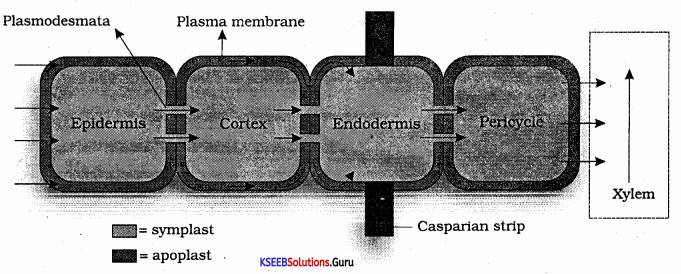
Question 34.
State Blackman’s ‘Law of Limiting Factors’ and explain the four factors affecting photosynthesis.
Answer:
Blackman’s Law of limiting Factors: The law states that “When a process is conditioned to its rapidity by the number of separate factors the role of the process is limited by the pace of the slowest factor”.
Factors affecting photosynthesis: The following factors influence photosynthesis:
1. Light: Sunlight is used as a primary source of energy. Its three aspects affecting the process are:
(a) Light Intensity: Optimum light intensity for photosynthesis is 2000-2500 foot candles/ Higher light intensity bleaches chlorophyll and is called solarisation.
(b) Light Quality: Photosynthetic rate is maximum in red light, next maximum in blue light, and least in green light.
(c) Duration: Photosynthetic rate is more efficient in intermittent light than in continuous light supply.
2. CO2: Used as a raw material in photosynthesis. Its concentration in air is 0.03%. Its increase up to 0.5% increases the rate of the process but above 0.5% inhibits photosynthesis.
3. O2: Liberated as a by-product in photosynthesis. Its increase above the normal 21% in air, decreases the rate of the process. It is called the Warburg effect.
4. Temperature: It affects photosynthesis through its influence on the enzyme-controlled dark reaction. The optimum temperature is 18 – 40°C for photosynthesis.
5. Water: Used as a raw material in photosynthesis. In the dehydrated state of cells, photosynthesis is inhibited.
![]()
Question 35.
Draw a neat labeled diagram of the alimentary canal of the Cockroach.
Answer:
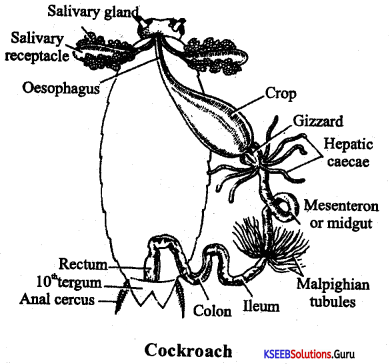
Question 36.
Give the schematic representation of the citric acid cycle.
Answer:
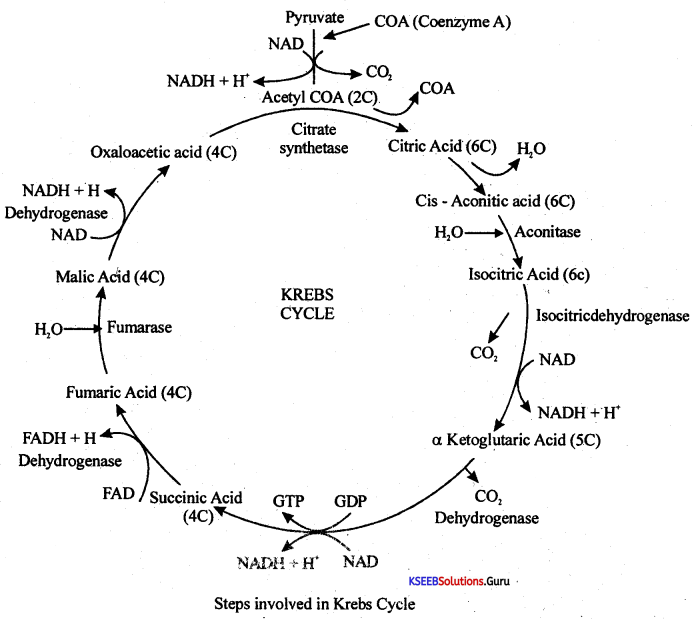
Note: To account for two molecules of acetyl CoA produced from 1 molecule of glucose the entire reaction has to be multiplied by two.
Bioenergetics:
1. Number of AlPs produced = 2
2. Number of NADH2 produced = 6 (6 × 3 = 18ATPs)
3. Number of FADH2 produced = 2 (2 × 2 = 4 ATPs)
The total yield of ATPs = 24.
Note: Efficiency of Krebs cycle along with its predatory reaction.is 30 ATPs.
Question 37.
Write one function for each of the following hormones :
(a) TSH
(b) ACTH
(c) ADH
(d) PTH
(e) Progesterone.
Answer:
(a) TSH: Stimulate thyroid hormones
(b) ACTH: Stimulate steroid hormones
(c) ADH: Reabsorption of water and electrolytes for a kidney.
(d) PTH: Increases calcium ions in the blood.
(e) Progesterone: Support pregnancy, acts on mammary glands